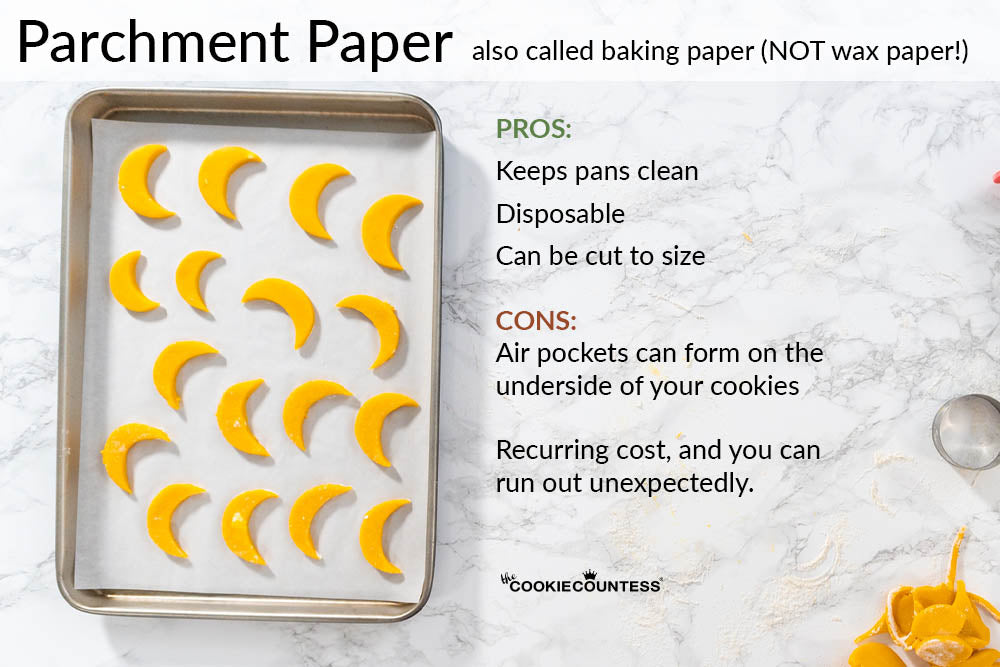
When to Use Parchment, Silicone, or Mesh Mats for Baking Cookies
Parchment paper, Silpat, mesh baking mats — oh my!
There are so many options for baking surfaces, it can make your head spin. Figuring out which one is right for you can take some time and experimentation, and I’m not going to lie — it can result in some ugly cookies along the way. But once you figure out which baking surface works best for your needs, you’ll find that your process moves much more smoothly.
What Are Baking Sheets? Know the Basics First!
Baking sheets (also called cookie sheets or jelly roll pans) are an absolute must when it comes to baking cookies. Many of them come in nonstick surfaces nowadays, which can offer quick release.
Some cookie sheets can discolor or tarnish over time, and that can affect how well your cookies bake—not to mention the cleanup! So, while your baking sheets are the foundation of your cookie-making empire, placing another medium between your pan and your cookies can really fine-tune your process.

Baking Cookies with Parchment Paper
Parchment paper is an easy and disposable way to line your pans. Not to be confused with wax paper (please please please, do NOT put wax paper in your oven, unless your intention is to light your oven on fire!), parchment paper can be found in any grocery store.
What is parchment paper? It is a food safe, nonstick, and heat-proof paper that is also grease- and moisture-resistant.
Wax paper, on the other hand, does not have the same heat-proof quality, so it can be very dangerous to try to swap these two interchangeably.
What are the PROS of baking on parchment paper?
- Keeps pans clean. Parchment paper keeps your pans grease-free.
- Disposable. It is disposable and relatively inexpensive.
- Comes in sheets or rolls. Parchment paper can be purchased by the roll, as well as in precut sheets for convenience.
- Cake and decorating uses. Parchment can also be used to line cake pans for easy cake-removal, as well as for achieving various effects during the cookie-decorating process.
What are the CONS of baking on parchment paper?
- Air pockets. When baking cookies on parchment, you may notice air pockets on the undersides of your baked cookies; because parchment is a solid piece of paper, there is nowhere for trapped air to go.
- Recurring cost. Parchment paper is also disposable, so there's a recurring cost associated with it. Silicone mats, outlined below, can be reused an infinite number of times.
How many times can I reuse the same sheet of parchment for my cookies? At least 3. If your parchment starts to show an accumulation of grease on top, simply dispose of that sheet in the garbage and replace it with a fresh one.

Baking Cookies with Solid Silicone Baking Mats (like Silpat brand)
Silicone baking mats are typically thought of as a step up from plain parchment paper. They create a solid nonstick surface on which cookies can bake evenly; they don’t conduct heat, so they don’t create hot spots or cause your cookies to burn.
What are the PROS of baking on Silpats?
- Reusable. This is obviously better for the environment than constantly throwing away parchment, but it is also easier on the wallet over time. This also eliminates the last-minute baking panic of realizing you are out of parchment paper!
- Can be used as a work surface. You can knead or roll out dough on this nonstick work surface.
- Keeps your pans clean. They protect your pans and keep them nice and clean.
What are the CONS of baking on Silpats?
- Air pockets. Just like with parchment, you may see small voids on the undersides of the cookies where air pockets formed during baking.
- Hand wash. These mats should typically be hand-washed and allowed to air dry (or placed in a warm oven for a few minutes). If easy and disposable are your requirements, stick with parchment—if washable and reusable is more your thing, baking mats are the way to go.
![]()
Baking Cookies with Perforated Mesh Baking Mats (our top pick!)
At first glance, these mats look very similar to the standard nonstick silicone mats. After all, they are coated in silicone, so they do offer the same nonstick properties. But that is where the resemblance stops. While standard silicone mats are one solid sheet of nonstick silicone, mesh mats are made up of a gridwork of tiny perforations. This allows air to flow around and under every cookie placed on the cookie sheet, which can result in more even baking.
What are the PROS of baking on Mesh Mats?
- Neat, professional bottoms. The bottoms of your cookies will end up with a beautiful pattern baked into it from the openings in the mesh.
- No air pockets. Since air can flow completely under the surface of the cookie, you won’t end up with the air pocket voids you see when baking with parchment or solid silicone mats.
- Less Spread. The increased airflow around your cookies can reduce the amount of spreading your dough does during baking. If making shaped cutout cookies, this can be a huge consideration.
- Easy to wash. In between batches, the mats can be wiped with a clean paper towel to absorb excess grease. Once baking is complete, simply hand wash the mats and allow them to air dry.
What are the CONS of baking on Mesh Mats?
- Cannot roll out dough on the mat. You cannot knead or roll out dough on these mats, since the dough can get stuck in the small perforations.
- Cannot use with very wet doughs or macarons. Perforated mats were originally made for use with baking bread; the increased air circulation in that process is also beneficial. You wouldn’t want to use them with a cookie like macarons or meringues, however, since these rely on the dough/batter having that solid contact with the pan or silicone mat.
- Doesn't keep your sheet pans perfectly clean. Since there are actual perforations through the mat, butter/grease can seep through the mats to the cookie sheet underneath during baking (dirty cookie sheets are a bummer, but the better bake you get from these mats is worth it).
Where can I find mesh baking mats?
The Cookie Countess makes and sell them in our online store. Since they're our top pick for baking cookies, we make them in three different sizes to fit the most popular sheet pan sizes.

Weighing the Pros and Cons
As you can see, there are benefits to each of these options. Just as you fine-tune your cookie recipes by adding more of one ingredient or adding less of another, so it is with selecting with surface on which to bake your cookies.
Ovens vary, elevation can play a huge role, and bakers’ preferences will always differ. But now that you know what you are looking for, you can make a more educated decision before you go to make your next batch of cookies.
Recommended for You:
Piping Bag Tip Tube Covers - Set of 4
AtecoDon't let your icing bags leak or dry out! Use these covers on bags with Ateco couplers and standard tips on them. Reuse them again and again. Se...
View full detailsBlack Fine Tip Food Marker
The Cookie CountessA black edible-ink pen is essential for your decorating kit. Use these high quality markers for: Marking up baked cookies for planning designs Wr...
View full detailsStainless Steel Measuring Cups 4 Piece Set
The Cookie CountessIncredibly high quality, with no plastic parts. Whether baking or cooking you'll reach for these essentials again and again! THESE ARE THE LAST SET...
View full detailsCookie Order Form 5 x 7, 50 sheets
The Cookie CountessThese cute sheets will help you plan your cookie orders. The back has an area for sketching and pricing planning. Size: 5" x 7" 50 Sheet Pad Doub...
View full details-

Introducing the Cookie Countess Cookie Capsule Collection!
Read nowTired of using boring clear bags as packaging for your beautiful decorated cookies? Or maybe you’ve been looking for a more protective way to package them that is just as pretty as the cookies themselves? Well, look no further than...
-

Stamped Jack-o-Lantern Cookies: an Easy Halloween Treat
Read nowSo you want to make Halloween cookies, but you don't really feel like making or using royal icing? Well, do we have the design for you! Look no further than the Cookie Countess Jack-O-Lantern cutter and stamps set to help...
-

Make and Decorate Easy Mini Jack-o-Lantern Cookies
Read nowHalloween is one of the biggest cookie holidays of the year, and I personally think that can be chalked up to the sheer number of fun/spooky/adorable/creepy designs this holiday lends itself to! Let's look at one of the most basic--Jack-o-Lanterns!...














Leave a comment